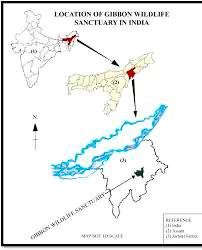The Northeast Frontier Railway (NFR) is planning to construct canopy bridges for Hoolock Gibbons to move across a railway track bifurcating Hollangapar Gibbon Sanctuary in eastern Assam.
- The Mariani-Dibrugarh railway track (1.65 km long) which is set to be doubled and electrified, divides the 2,098.62-hectare Hollongapar Gibbon Sanctuary in Assam into 2 halves.
About Canopy Bridge

- Aim: The decision to install canopy bridges is to facilitate easy movement of the gibbons across the track.
- Designed: The canopy bridges are designed by the WII in consultation with NFR.
- Design: The ends of the canopy bridges as well as the knots will be secured and clamped or tightened using appropriate and high-grade fastening materials and techniques.
- Safety mechanism: To save the species from accidentally falling off the bridges, safety nets will be installed below the main twin-rope bridge as a fail-safe mechanism.
- Natural design: The canopy rope bridges is supposed to mimic the natural design with lianas and creepers being guided along them.
Enroll now for UPSC Online Course
Hollangapar Gibbon Sanctuary

- Location: In Jorhat district of Assam.
- Nature: The Hoollongapar Gibbon Sanctuary is a protected area of evergreen forest.
- Established: The sanctuary was officially established and renamed in 1997 and is the only sanctuary in India named after a gibbon due to its distinction for containing the densest gibbon populations in India
- Unique Wildlife:
- The Sanctuary contains India’s only Ape’s ie. the Hoolock gibbons
- It is home to northeastern India’s only nocturnal primate ie. the Bengal slow loris.
- Highest Primates density: The Sanctuary is home to six other primate species, making it an area with the highest biodiversity of primate species of any Protected Area in the country.
- Flora: The sanctuary has a rich diversity of flora at each layer in the canopy.
- The upper canopy: It is dominated by the Hollong tree, but other species found are Sam, Amari, Sopas, Bhelu, Udal and Hingori
- The Middle canopy: Nahar dominates the middle canopy.
- The lower canopy: It consists of evergreen shrubs and herbs.
Western Hoolock Gibbon

- About Hoolock Gibbon: The Hoolock Gibbons are three primate species of genus Hoolock in the gibbon family, Hylobatidae.
- Western Hoolock Gibbon is the only Gibbon species found in India
- Native: To eastern Bangladesh, Northeast India, Myanmar, and Southwest China.
- IUCN Status: Endangered
- Habitat: They are found south of Brahmaputra and the North Bank areas and east of the Dibang Rivers.
- Range in India: It extends into the seven northeast states covering Arunachal Pradesh, Assam, Manipur, Meghalaya, Mizoram, Nagaland, and Tripura.
- Population: The Hoolock Gibbon Sanctuary supports 125 Individuals of the species, as of 2023
- Characteristic: They are diurnal and arboreal in nature.
- Threats:
- Fragmentation of Forest: The Hoolock Gibbon Sanctuary is divided into halves, segregation the population of the species, due to the construction of a railway line.
- Electrification and expansion of rail and road infrastructure
- Hunting
Enroll now for UPSC Online Classes
![]() 1 Jun 2024
1 Jun 2024



